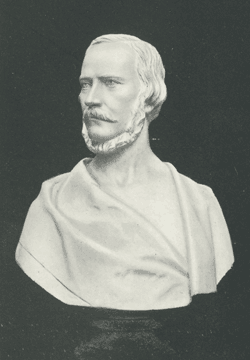George Francis Mulvany, Portrait and Subject Painter
(b. 1809, d. 1869)
Portrait and Subject Painter
From A Dictionary of Irish Artists 1913

George F. Mulvany, R.H.A. Plaster Bust, by Joseph Watkins, R.H.A.; in the National Gallery of Ireland.
Was born in Dublin in 1809, the second son of Thomas James Mulvany, R.H.A. (q.v.). He grew up amidst the surroundings of art, his father being Keeper of the Royal Hibernian Academy from its foundation until his death, and he early displayed indications of artistic ability. He studied in the Academy School, and after spending some time in Italy he began to exhibit, sending his first contribution to the Academy in 1827. No young artist showed greater promise, and in 1830 he was elected an Associate and five years later, in 1835, a full Member. On the death of his father in 1845 he was elected to succeed him as Keeper of the Royal Hibernian Academy. The establishment in 1839 of the Royal Irish Art Union, which exercised a considerable influence upon art in Ireland, enlisted his enthusiastic support, and he took a prominent part in the promotion of the Royal Irish Institution formed principally with the object of founding a NationalGallery in Dublin. To his untiring energy and to the munificence of Sir Maziere Brady and a few other Dublin citizens interested in art, the National Gallery of Ireland owes its existence. After some years of patient and persistent exertion Mulvany saw his hopes realized. The first stone of the Gallery was laid on the 29th January, 1859, and the building was opened by the Lord Lieutenant, the Earl of Carlisle, on 30th January, 1864. On the 6th September, 1862, Mulvany was appointed Director of the Gallery. Of much sound sense and ability, and of pleasing manners, he was, considering the limited powers accorded to him by the Board of Governors, undoubtedly successful as a Director. He possessed good judgment and, for the time, no inconsiderable knowledge of art; and he cannot be held wholly responsible for the mass of inferior pictures acquired for the Gallery in its early days, which are now buried in its vaults.
Mulvany continued painting up to the last; he exhibited in the Royal Hibernian Academy from 1827 to the year of his death, and sent works to the London Academy in 1836 and 1839. He was a prolific painter, producing a large number of portraits and subject pictures. Though his portraits were occasionally good, his work was, as a rule, commonplace and feeble in execution and unpleasantly brown in colour. He worked chiefly in oil, but occasionally produced small crayon portraits. In 1847 he published a pamphlet, "Thoughts and Facts concerning the Fine Arts in Ireland, and Schools of Design." He died, after a short illness, in his house in Herbert Place, Dublin, on the 6th February, 1869, and was buried on the 10th at Mount Jerome, the members of the Royal Hibernian Academy attending in a body to pay a last tribute of respect to an old and valued member.
Among pictures by Mulvany are the following:
John Banim. [National Gallery of Ireland.] R.H.A., 1835.
Sir Maziere Brady, Chief Baron of the Exchequer, afterwards Lord Chancellor. [The late Sir Francis Brady, Bart.] R.H.A., 1841.
Sir John Fox Burgoyne. Lithographed by J. S. Templeton.
Frederick W. Burton, R.H.A. [National Gallery of Ireland.]
Charles W. Cobbe, of Newbridge, Co. Dublin. R.H.A., 1840.
W. Conran. Drawing, lithographed.
Peter D'Arcy. A small portrait on panel. [James F. D'Arcy, D.L., Dublin.]
William Dargan. R.H.A., 1854 and 1856. Engraved by W. J. Edwards as frontispiece to Sproule's "Catalogue of the Dublin Exhibition of 1853."
Rev. C. M. Fleury. Lithographed in 1849.
Dr. Henry, President of Queen's College, Belfast.
Sir Robert Kane. R.H.A., 1849. Engraved by S. Freeman.
Sir Robert Kane. Crayons. Lithographed by Day and Son and published in Dublin by J. Cranfield.
Charles Kean as Hamlet. R.H.A., 1840.
Richard Robert Madden. R.H.A., 1851. Engraved by S.Allen as frontispiece to Madden's "United Irishmen."
Christopher Moore, sculptor. Miniature portrait. R.H.A., 1845.
Thomas Moore. R.H.A., 1837. Engraved in mezzotint by J. R. Ward in 1837 and published by Mulvany.
John George Mulvany, R.H.A. [Miss A. C. Mulvany, Dusseldorf.] R.H.A., 1829.
Thomas James Mulvany, R.H.A. [Miss A. C. Mulvany, Dusseldorf.] R.H.A., 1829.
William T. Mulvany. [Miss A. C. Mulvany, Dusseldorf.] R.H.A., 1848.
Helen O'Callaghan. [Miss A. C. Mulvany, Dusseldorf.]
Daniel O'Connell. [National Gallery of Ireland.] R.H.A., 1854.
Sir Michael O'Loghlen, Master of the Rolls. [King's Inns.] R.H.A., 1843.
Hon. H. Pakenham, Dean of St. Patrick's. R.H.A., 1849.
Rev. C. E. Tisdall, R.H.A., 1849. Lithographed by H. O'Neill.
An Incident in the Life of the Duke of Alva.
The White Man cast on the Red Man's Shore. R.H.A., 1841. The first of a series intended to illustrate the progress of Europeans in America.
The Wandering Lascar.
St. Patrick baptizing the King of Munster. R.H.A., 1845. Purchased by the R.I. Art Union and won as a prize by Lord Talbot de Malahide.
The Peasant's Grave.
First Love.
The Village Orphans. R.H.A., 1856.
Francis the first surprising Henry VIII in his Castle of Guisnes. R.H.A., 1861. Purchased by the Art Union of Ireland.
Scene from "Two Gentlemen of Verona." [Earl of Meath.]
The Infant Bacchus. R.A., 1836.
Various Attractions, a Scene in London, R.A., 1839.
« Bernard Mulrenin | Contents and Search | John George Mulvany »
